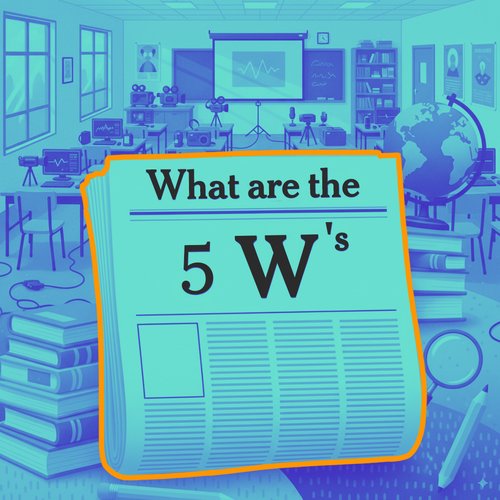
Students will learn and practice asking strong questions using the 5 W’s: Who, What, Where, When, and Why.
Use this lesson during language and literacy units. This lesson can be paired with an existing curriculum for English.
Students learn how to ask questions to gather information for accuracy. Students will practice gathering reliable, accurate information by asking strong, purposeful questions, just like journalists do.
Empowers students to be curious, informed citizens who ask critical questions and seek multiple perspectives.
Open the lesson with a class discussion on the importance of asking questions.
Create a thought bubble chart to write down class ideas. Together, discuss why we ask questions, and what words you use to frame them. If students are stuck, show examples on the board of questions that they use in the classroom.
Ex. “What time is recess today?”
As a class, reflect on the importance of setting up questions to get your desired information.
Prompt: What do strong questions help us do?
Discuss how curiosity helps us learn, connect, and even spark change.
Using a piece of paper, ask students to write down:
This resource is part of the Elementary Express Toolkit geared toward Grades 3-6.
Journalism is the activity of gathering, assessing, creating, and presenting news and information.
A group of people who live in the same area (such as a city, town, or neighborhood). It can also be a group of people who have the same interests, religion, race, etc.
Awareness of the elements of environment through physical sensation or intuitive cognition. A capacity for comprehension and understanding.
In news, it’s a story’s point or theme. It's the lens through which the producer or writer filters the information they have gathered and focuses it to make it meaningful to viewers or readers.
A conversation between two or more people where the purpose is to gather information and facts. The interviewer asks questions and the interviewee provides information based on their knowledge about a specific topic or issue.
An account of past or current events. In journalism, stories are presented with a combination of people, facts, and typically includes a beginning, middle and end.
The term “empathy” is used to describe a wide range of experiences. A generally definition is the ability to sense other people’s emotions, coupled with the ability to imagine what someone else might be thinking or feeling. In media-making, creators can have empathy for their subjects and the audience can empathize with the characters.
Something that is known or proved to be true.
An investigation into and study of sources in order to establish facts and reach new conclusions.
Free from mistake or error. Coverage of topics and facts in appropriate detail.
A question that comes after an interview subject responds to an initial question asked by the interviewer. A good follow-up question derives from listening to what the interviewee is saying and determining how best to help them elaborate and share more information.
A desire to learn and know about something or anything.
Determine the kinds of sources that will be helpful in answering compelling and supporting questions, taking into consideration multiple points of view represented in the sources, the types of sources available, and the potential uses of the sources. (NCSS D1.5.9-12)
Explain points of agreement and disagreement experts have about interpretations and applications of disciplinary concepts and ideas associated with a supporting question and explain how supporting questions contribute to an inquiry and how, through engaging source work, new compelling and supporting questions emerge. (NCSS D1.3.9-12 - D1.4.9-12)
Students leverage technology to take an active role in choosing, achieving and demonstrating competency in their learning goals, informed by the learning sciences. (ISTE)
Students critically curate a variety of resources using digital tools to construct knowledge, produce creative artifacts and make meaningful learning experiences for themselves and others. (ISTE)
Historical understanding requires recognizing this multiplicity of points of view in the past, which makes it important to seek out a range of sources on any historical question rather than simply use those that are easiest to find. It also requires recognizing that perspectives change over time, so that historical understanding requires developing a sense of empathy with people in the past whose perspectives might be very different from those of today. (NCSS D2.His.4.9-12 - D2.His.8.9-12)
Journalism
Media Literacy
Education
Tutorials
Lessons
Beginner
White board, chalkboard or other visual board
Online Worksheet
Notebook
Two Class Periods